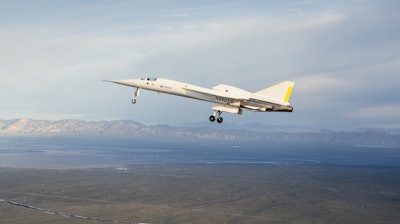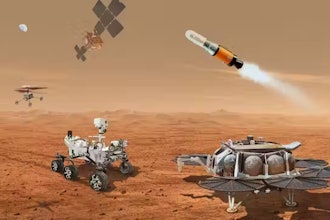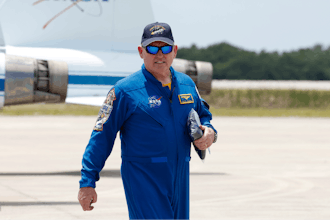
Boom Supersonic's XB-1 secured the first-ever Special Flight Authorization (SFA) to Exceed Mach 1 from the Federal Aviation Administration (FAA). XB-1 test flights will continue to be conducted in the R-2508 Complex and supersonic operations will occur in the Black Mountain Supersonic Corridor and in a portion of the High Altitude Supersonic Corridor within the R-2515 airspace, which has been used extensively for research and military supersonic aeronautical operations. XB-1’s SFA follows a thorough review and Environmental Assessment, and extends to specified chase plane aircraft, which will trail XB-1 to observe, monitor and record safety of flight.
The SFA comes just weeks after XB-1, the world’s first independently developed supersonic jet, took flight at the Mojave Air & Space Port in Mojave, California on March 22, 2024. XB-1 was flown by Boom Chief Test Pilot Bill “Doc” Shoemaker, and Test Pilot Tristan “Geppetto” Brandenburg flew the T-38 chase aircraft which monitored XB-1 in the air. XB-1’s first flight occurred in the same airspace that hosted many historic first flights, including the flights of the Bell X-1, the North American X-15 and the Lockheed SR-71 Blackbird.
Most Read on IEN:
- Toxic Ingredients Found in Weight Loss Supplements
- Major Auto Supplier Faces Fine After Fatal Crushing Accident
- Philips, Which Made Millions of Defective CPAP Machines, Ordered to Overhaul Manufacturing
- Tesla to Cut More Than 10% of Workforce
Now that XB-1 has successfully completed its first flight and received authorization to fly supersonic, the team will systematically expand the flight envelope to confirm its performance and handling qualities through and beyond Mach 1. This includes in-flight checks of all systems, as well as multiple test points demonstrating safe margin to flutter (vibration) boundaries. There are a total of 10-20 flights planned before reaching supersonic speeds.
When XB-1 is ready for its first supersonic flight, Test Pilot Tristan “Geppetto” Brandenberg will be at the controls. Geppetto flew the T-38 chase aircraft which monitored XB-1 in the air during its inaugural flight. Chase planes accompany new aircraft to observe how the test plane is handling and verify things like altitude, airspeed and airworthiness during flight. Geppetto is a graduate of the United States Naval Test Pilot School and TOPGUN Adversary. He has completed 2500 total flight hours in 30 different aircraft and executed over 200 carrier arrested landings. He tested new systems on the F/A18 Super Hornet before they were released to the fleet.
“Being in the air with XB-1 during its maiden flight is a moment I will never forget,” said Geppetto on XB-1’s first flight. “The team has been working hard to get to this point and seeing today’s flight through mission completion is a huge accomplishment for all of us.”
Currently, the team is looking forward to the second flight, where the landing gear will be retracted and extended.
“We anticipate taking it up to 16 degrees AOA (angle of attack and will also evaluate the sideslip which will expand the envelope in order to give us a little bit more margin on a nominal landing. It will also be the first time the ‘dampers’—or stability augmentation system—is used,” says Brandenburg.
The third flight will evaluate XB-1’s flutter excitation system. Flutter is a self-excited instability which can occur because of interactions between aerodynamic and inertial forces.
“Right now, the plan is multiple supersonic flights. We plan to do Mach 1.1, 1.2 and 1.3 on the first three. The reason for that is each one of those points takes so much airspace that you only have time to do one of them, so we will be on condition for several minutes, we’ll get a flying qualities and handling qualities block and have to come back home,” says Brandenburg.
Click here to subscribe to our daily newsletter featuring breaking manufacturing industry news.






















